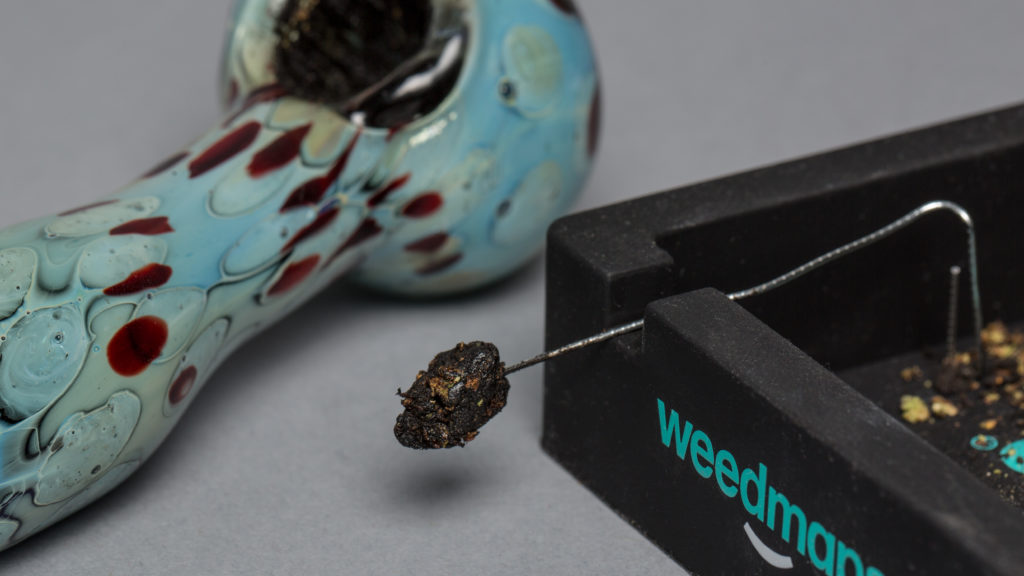Resin is both a sticky insoluble organic compound secreted by plants and the tar-like residue that builds up in pipes, bongs, and other glass pieces after many sessions of cannabis combustion. Some people may also use the term resin to refer to live resin, a solvent-based concentrate made from fresh cannabis plants. But product labels always specify live resin in this case.
 Photo by: Gina Coleman/Weedmaps
Photo by: Gina Coleman/WeedmapsImage lightbox

Resin from the plant
You've probably noticed the tiny hairs that cover the cannabis plant, creating a crystal-like sheen and sticky feel. These glandular hairs are called trichomes. These trichomes are held together with resin, which contains the cannabinoids, terpenes, and other compounds for which the cannabis plant is known. You can think of weed resin as the stuff that holds all the trichome-produced compounds together on the trichome head.
Cannabis produces resin primarily to deter pests. Resin is bitter and contains specific terpenes that repel certain pests. Linalool, for example, is a common terpene in cannabis that used as an ingredient in insecticides due to its pest-killing properties. Resin also protects the plant from overexposure to ultraviolet (UV) rays and helps it maintain optimal surface-level humidity so the plant doesn't dry out.
How is resin collected from the cannabis plant?
Hashish
Hashish, or simply hash, is a solvent-free cannabis concentrate composed of weed resin or trichome glands. Hash-making is an ancient art dating back thousands of years. It involves sifting a cannabis plant to harvest the resin glands, then compressing those glands under mild heat.
Charas
Charas is made by hand-rubbing the still-growing cannabis plant then rolling the collected resin into small balls.
Dry sift
Dry sift, also known as kief, is resin sifted from cannabis through a sieve. Dry sift can be pressed and heated to create hash, sprinkled into a joint or bowl, or used in edibles.
Pros of collecting resin
There are a number of uses for cannabis resin — some more effective than others. When you separate resin from the cannabis plant, you're essentially gathering all of the plant's desirable compounds. Collecting resin from a cannabis plant is like customizing a social media feed to only show you things you want to see. You're separating the active compounds from the raw plant material, distilling the plant's potency and effects. Concentrates made from resin glands are inherently more potent than flower, accounting for the meteoric rise of concentrates within the cannabis market.
With proper protection from outside elements — heat, humidity, light, and air — weed resin can have a long shelf life. Resin also naturally protects its own cannabinoids from oxygen, especially when pressed into hash, which causes the resin to darken. This dark brown color and opaqueness protect active compounds from UV light, extending the product's shelf life.
Resin from a pipe
Cannabis combustion creates byproducts — mostly ash, tar, and carbon — that build up in smoking implements like pipes and bowls.
 Photo by: Gina Coleman/Weedmaps
Photo by: Gina Coleman/WeedmapsImage lightbox

Does smoking pipe resin get you high?
In general, the THC content of resin that's built up in a bong or pipe is quite low. And while there may be some residual THC in resin, it will taste harsh and contain more tar than useful compounds. In short, smoking resin found in a bong is something people do, but the risks outweigh the benefits.
Regardless of whether it is derived from cannabis or another source, smoking tar is harmful. You may not have experienced any dangerous side effects if you've taken resin hits from your pipe or bowl once or twice in a pinch. But it's probably worth waiting until you get some more flower or concentrate, rather than smoking something with minimal THC content that's also worse for your lungs.
Frequently asked questions
What's the best way to remove resin from your pipe and hands?
Place your pipe or bowl in a sealable plastic bag and fill it with rubbing alcohol until the entire piece is submerged. Add a teaspoon of table salt (sodium chloride) or Epsom salt (magnesium sulfate), either of which will act as a scrubber or sponge for the resin. Leave the pipe or bowl to soak in the bag for about 12 hours, giving the alcohol enough time to dissolve the resin.
Rubbing alcohol is also a fast and effective method for removing resin from your hands. Rubbing your fingers with vegetable or olive oil may also safely remove resin and be more gentle on your skin.
How much THC is in resin?
Leftover resin does not contain very much THC. Instead, the sticky resin that builds up in your pipes, bowls, vaporizers, and bongs is mostly tar, ash, and carbon — all by-products of the combustion process. Ultimately, leftover resin does contain some THC, and you might even feel a little bit high after smoking it, but compared to flower and concentrates, the leftover resin is very low in THC and the health risks outweigh the benefits.
Can you use a vaporizer to smoke resin?
Yes, it's possible to consume pipe resin using a vaporizer. However, similar to smoking resin, you're unlikely to get a sufficient amount of cannabinoids and terpenes. Putting resin in your vaporizer may also gunk it up and negatively impact the smell and taste of your vape hits.

